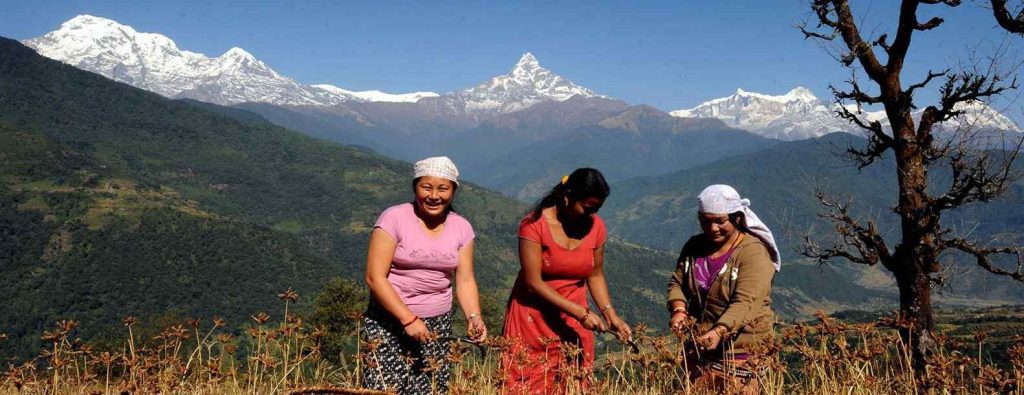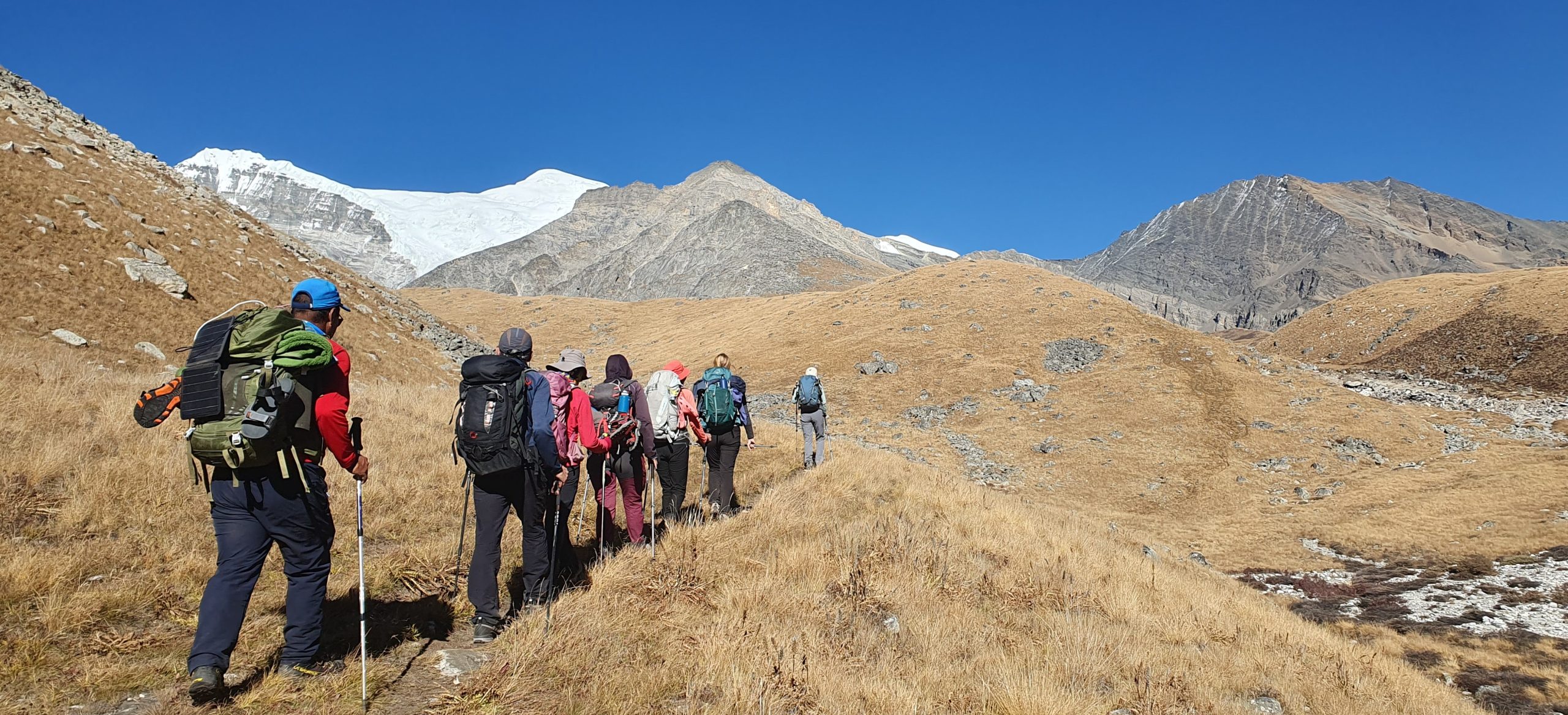Where Mountains Meet the Sky – Annapurna Ridge Trails
As sunshine brightens the snow-specked ridge of peaks, you drink steaming tea on a mountain ledge. Down below, terraced fields stretch across hillsides, and prayer flags dance in the breeze. This isn’t just some picture postcard—this is the actual reality on the Annapurna Ridge Trails, a walk designed for those who have never been trekking before but who are eager to experience the Himalaya for the first time.
In many ways, it is the less demanding cousin of other treks and challenges, but what it offers is a great opportunity to experience Nepal’s mountains without needing a whole lot of previous experience or an essential fitness level to be on board. It’s where adventure meets accessibility, where Himalayan dreams become attainable reality.
2025 Departure Dates
Join us on one of our strategically planned departure dates that align with the region’s best trekking conditions:
- October 6, 2025
- October 20, 2025
- October 27, 2025
- November 3, 2025
- November 10, 2025
These autumn dates feature clear mountain views, comfortable daytime temperatures, and cool, refreshing evenings. With stable weather and spectacular visibility, this season showcases the Himalayas at their finest. We recommend booking early, as our small-group treks fill quickly, especially the late October departures when conditions reach peak perfection.
Why Choose Annapurna Ridge Trails Treks?
When most people think of Himalayan trekking, they envision difficult environments, extended hiking days, and weeks of effort. The Annapurna Ridge Trails, however, is a totally different experience: a true mountain experience in a very condensed timeframe of only six days.
You will not be enduring weeks away from home or reaching for oxygen thin altitudes. Instead, in less than a week, you can be rewarded with dramatic scenery, authentic cultural experiences, and stunning mountain views. The trail passes through traditional villages, where people live off the land much as they have for thousands of years, and still provides comfortable accommodations and dependable meals.
Each day brings new terrain—from lush forests to open ridgelines with sweeping views of the Annapurna range, including the sacred Machapuchare (Fish Tail Mountain) that has never been summited out of respect for local beliefs.
The Mountain Landscape
Annapurna is part of the greater Himalayas, the highest mountain system in the world, created by the convergence of tectonic plates, namely the Indian plate and the Eurasian plate. As a result of this geographical phenomenon, the Himalayas continue to grow millimeters every year.
The Ridge Trails follow ancient trade routes between Tibet and the Indian subcontinent. As you hike, you will gradually traverse several ecological zones, from subtropical forests in the low elevations to cool alpine environments in the higher elevations.
Rivers receiving glacial melt have created deep valleys across the region, resulting in the characteristic terraced farmland in a classic rural Nepal setting. This complex landscape supports an amazing diversity of plants and animals, with hundreds of bird species and thousands of varieties of plants, many of which are used in traditional medicine.
Cultural Heritage
Primarily Gurung and Magar communities live in the Annapurna region, each group has distinct traditions, architecture, and customs. The villages in the Annapurna region are primarily stone houses with slate roofs (sometimes they are adorned with carved wooden features that show generations of craftsmanship).
The rich culture of the region draws from Buddhism, Hinduism, and ancient nature-based belief systems. While you are in the Annapurna Region, take note of the prayer flags scattering blessings through the valleys, mani walls (stone structures with inscribed prayers) lining the paths, and stupas on important spiritual sites.
Village life revolves around agriculture, with families tending terraced fields using methods passed down through the centuries. Traditional crafts remain important economic activities, with distinctive weaving, basketry, and woodworking styles specific to each community.
What to Expect on the Trek
Accommodation
Throughout your journey, choose to stay at traditional teahouses and lodges. Enjoy the unique experience of sharing space with families who run these establishments; the family-run lodges often offer you a private twin room with a shared bathroom and dining area where travelers and families gather to share stories and meals.
These accommodations are basic by any city standard, however, they are clean and comfortable and serve their purpose of sleeping, eating, and washing after a day of hiking. Most teahouses and lodges will have solar-heated showers, and some will offer rooms with private bathrooms for an extra cost. There are no more lavish accommodation options on your trekking adventure, but the best part of these lodges is the view of the mountains from your window and the hospitality of the families who serve you.
Each night brings a different village with its own character—from larger settlements with small museums and craft shops to intimate hamlets where you might be the only visitors that day.

Food and Dining
Hiking creates healthy appetites, which is matched by the teahouse kitchens providing a hearty, filling meal. The staple food is dal bhat – steamed rice with lentil soup and vegetable curry, usually with pickle and papad (crispy flatbread). This food gives you excellent nutrition and energy for hiking while being traditional local food.
Most lodges will also have international food like pastas, noodle dishes, and pancakes. Breakfasts may include porridge, eggs, and/or Tibetan bread with honey. All the way through the trek, you’ll be able to try the regional food and enjoy the new tastes.
Most dietary requirements can be accommodated with advance notice. Clean drinking water is available for purchase as bottled or filtered water, or you can bring purification tablets to treat local water yourself.
Guides and Porters
Our skilled guides are more than just navigators—they share impressive cultural knowledge, point out distant mountains, and keep you safe throughout the journey. Many guides will be from the region and speak local languages, enabling them to facilitate interactions with locals in the villages.
Porters will carry most of your gear, so you can hike with just a daypack containing water, camera, and daily basics. These are skiilled professionals, and they are often from mountain communities, working under the right conditions, and they have a remarkable capability of balance, strength, and endurance on the trails.
We ensure fair treatment for all team members, with proper equipment, insurance coverage, and appropriate compensation. The friendships formed with these guides and porters often become treasured memories from the trek.
Practical Details
Permits and Costs
The trek requires two permits:
- Annapurna Conservation Area Permit (ACAP): approximately €25)
- Trekkers’ Information Management System (TIMS) card: around €15
These fees support conservation efforts, trail maintenance, and community development projects throughout the region.
Physical Preparation
While aimed at novices, the trek still requires base fitness. Each day of hiking will be about 4 – 7 hours a day, with fluctuating terrain and some steep parts. Preparing with regular cardiovascular training, hill training on some weekends, and as much weekend hiking as possible in the months leading up to your departure will enhance your overall trek experience.
In reference to altitude, the route remains below 3,200 meters of elevation which is one of the advantages of this trek as potential concerns for altitude sickness is not an issue in comparison to higher treks, however, the itinerary includes a suitable amount of acclimatization, and all guides will hold the responsibility of monitoring trekkers for any altitude related issues.
Essential Packing
Mountain weather can change quickly, requiring versatile clothing that adapts to different conditions. Key items include:
- Waterproof hiking boots with ankle support (broken in before the trek)
- Moisture-wicking base layers and warm mid-layers
- Waterproof jacket and pants
- Warm hat, gloves, and neck gaiter
- Trekking poles to reduce strain during descents
- Sleeping bag (rated to 0°C/32°F)
- Headlamp with extra batteries
- Water bottles and purification methods
- Basic first aid supplies and personal medications
Most equipment can be rented or purchased in Kathmandu or Pokhara if needed, though items like boots should be personal and well-fitted beforehand.
Note: Glacier Safari Treks also provides you with a customized packing list to ensure you don’t overpack or underpack.
Beyond the Trek
The lakeside activities that are located in Pokhara allow for some nice rest and relaxation along the water after trekking, and you can do optional activities such as boating/paragliding/spa. Chitwan National Park allows you to see wildlife in a totally different ecosystem as well. The Kathmandu Valley has many sites designated as World Heritage Sites, and if you have time, there are many temples, towers, and royal squares to explore!
Your Himalayan Journey Awaits
Annapurna Ridge Trails provides you with the ideal introduction to trekking in the Himalayas. It’s challenging enough to be rewarding; accessible enough for you to enjoy; honest enough to capture Nepal’s mountain magic.
You’ll return home with wonderful shots of the Himalayan mountains, but something more of value than a great shot—confidence in your abilities—cultural perspectives—and that special view that can only come from walking beside the world’s highest mountains.
For those who’ve always dreamed of Himalayan adventure but felt intimidated by longer, higher-altitude treks, the Annapurna Ridge Trails opens the door to one of the world’s most spectacular mountain regions. The question isn’t whether you can handle this trek—it’s when you’ll take your first step on the trail.
FAQs
- Do I need prior trekking experience for the Annapurna Ridge Trails?
No, this trek is designed for beginners. It’s a great introduction to Himalayan trekking without requiring high-altitude experience or technical skills. - What’s included in the cost of the trek?
The cost typically includes guides, porters, accommodation in teahouses, meals during the trek, necessary permits, and transport to/from the starting point. - What kind of fitness level is required?
A moderate level of fitness is helpful. Expect to walk 4–7 hours a day on varied terrain. No extreme endurance is required, but some pre-trek cardio or hiking practice is recommended. - What kind of accommodation can I expect?
You’ll stay in teahouses—basic but clean and cozy lodges run by local families. Rooms are usually twin-share with shared bathrooms, and some have hot showers and private options. - When is the best time to go on this trek?Autumn (October to November) is the best season due to clear skies, stable weather, and excellent mountain views. Book early, especially for late October departures.

